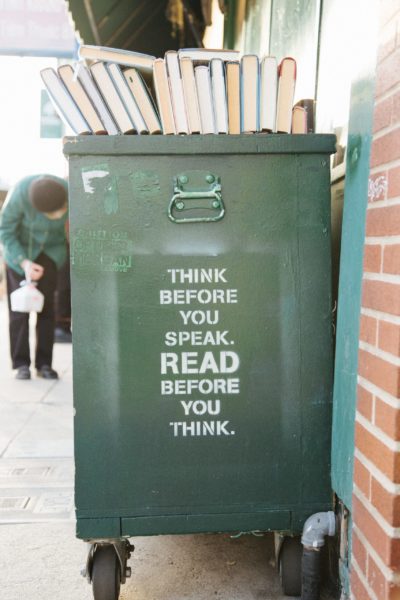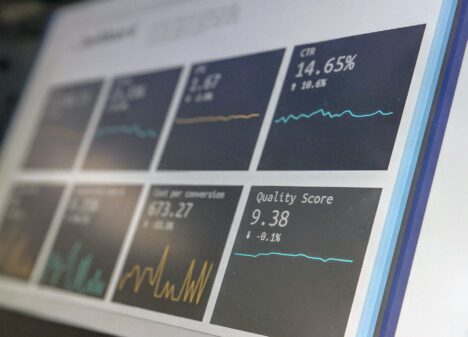Almost a century ago, writer Virginia Woolf noticed people’s tendency to approach books “with clouded and divided minds, asking fiction to be true, poetry to be false, biographies to be flattering and history to chime with prejudices.”
Critical reading implies an in-depth analysis of the text, of the messages this conveys, of the arguments on which the writer’s affirmations stand and represents “the most common way to practice critical thinking”. While always necessary, the evaluation of a text may seem a laborious or toilsome process. That is precisely why, in order to acquire the necessary skills for the quick evaluation of a text, a guide that briefly presents a methodology to check the credibility and logic of a text comes in handy.
Good sources vs. doubtful ones
Because most readers nowadays look for information sources on the internet, it’s important to know which are the best methods to discern between good and biased, outdated or inaccurate online sources.
In the case of an online document, one must first check the site’s domain name. Generally, at an international level, a site whose domain ends in the letters “.edu” (educational) or “.gov” (government) is a credible one (although some sites may use these suffixes in order to inspire trust, and governments will put forward a perspective on events that does not reflect poorly on themselves). Online domains ending in “.org” (nonprofit) may contain credible information, but it’s necessary to check the organization’s purpose and agenda to decide whether the offered information is impartial or is influenced by the biases of those providing it. Some commercial sites (.com) may be reliable sources, especially if they belong to well-known media agencies, but it’s very important to check their trustworthiness. When it comes to identifying sites which bombard us with unwanted information, the ending “.info” has proved to be the best clue.
The second step to take is to get additional information on the text and its author. The publishing date is important. At least, in those areas where information becomes quickly outdated. The author may present information from other credible sources or his own ideas, supported or not by facts and arguments. Checking the author’s accreditation is also useful – academic writing experience and competency, previously published subjects, if the author is frequently quoted by other experts (in the case of scientific studies, for instance), the author’s possible association with a known institution or organisation (and, in this case, the identification of their values and objectives) and, last but not least, checking whether the approached subject belongs to the author’s area of competence.
We must always check information we got from different sources on the internet, using reliable sites as sources. It’s important to note that Wikipedia, blogs or online forums may be used only as starting points in getting information sources or supporting evidence but not as sources or evidences in and of themselves (unless of course, they are the subject of the writing).
Other evaluation guidelines
Usually, a text states an idea and argues in its favor or, on the contrary, against it. The most frequently used arguing methods in essays are comparing different opinions, directly or indirectly showing which one is the better; listing the reasons for which an idea deserves validation; rejecting counterarguments which critics may bring to an idea supported by the author. Some texts may use only one of the mentioned arguing methods, others may use them all. For instance, an author may present their readers with a list of options from which he would then, by comparison, underline only one as valid, to then list all the reasons for which this deserves validation and to finally close by rejecting all possible counterarguments the ones criticizing his position might have.

Photo by Sixteen Miles Out on Unsplash
There are also more stylistically complex texts, which may attempt to support the author’s idea in more subtle, at times, implied ways—ways where the author’s purpose is not stated and it is left for the reader to determine their main argument or important points. For instance, a narrative text may support an idea of the author just by building a highly suggestive scene for the reader. The Bible is a good example of both arguing types already mentioned. In the Bible we find passages directly affirming the author’s main points or ideas and then listing the arguments (like in most of the speeches of the apostle Paul), but also passages in which the message is conveyed by the account of certain events (the best known are, of course, Jesus’ parables).
In the case of the latter, the gospels prove that even Jesus’ disciples asked Jesus, in certain cases, to explain the significance of His parables, which points out our need to practice our capacity to discern the author’s messages and arguments in a text and their validity. All the more so as, aside from the manner in which a text may apparently mask the author’s message and arguments, we have another big obstacle standing in the way of the objective critical analysis of texts. As John Steinbeck puts it in The Winter of Our Discontent: “A story has as many versions as it has readers. Each of them takes what he wishes or is able out of it and changes it as suited.”
The evaluation of the validity of a text’s arguing methods usually takes particular forms. What works for one mind might not work the same way for others. There are however some principles which are able to guide anyone in forming critical reading strategies that can be used in the examination of texts.
Identifying the tenet
Identifying the main idea of a text is the most important phase of an evaluation. In academic works, the tenet is explicitly presented in the beginning. However, regardless of it being obvious or implicit in other texts, the tenet must be detected and kept in mind, so that the reader may establish whether the arguments supporting it are satisfying or not. Drafting a visual “map” of the key concepts or ideas in the text may enable one to better understand the material and to quickly identify its tenet—and as a result, keep it in mind throughout the reading process. This “map” could be a metaphorical one confined to the readers mind, or it could be created as part of a note-taking regimen. Another way to help identify the main tenet is to rephrase it in your own words, or relate it to your own experience.
Identifying the arguments supporting the tenet
Weighing arguments is an endeavor whose difficulty varies also depending on the author’s style or competence. Usually, arguments are in their turn supported by other arguments. For instance, a journalist supported the tenet according to which cigarettes should become illegal, by arguing that smoking is fatal. This first argument was supported by the one offered by statistics regarding the connection between smoking and cardiovascular, pulmonary, cancerous diseases, concluding that any life-threatening product should be banned by law. The (wrong) assumption made by the journalist was that people will accept his second argument without it being in its turn supported by other arguments, which would complete the demonstration. This does not mean that a conclusion that has been insufficiently argued cannot be accepted in exceptional cases. During the Second World War, President Roosevelt agreed to the proposal received by a letter signed by physicists Leó Szilárd and Albert Einstein, asking him to support the research regarding the atomic bomb, suggesting that the Germans had already started building such a weapon. Although the President received no arguments proving that the physicists had the necessary means and knowledge to build the first nuclear bomb, the request was granted due to the scientific authority of its signatories.
Detecting the persuasion intention
Sometimes, authors recur to rhetorical or stylistic devices which are irrelevant for making an argument, but which may create a form of persuasion. The reader must be careful not to agree with the author’s tenet just because he fancies his writing, because he expresses himself in an elegant, funny, intelligent or stylistically captivating manner. This forms of gaining the reader’s allegiance are irrelevant when it comes to the evaluation of the validity of the author’s argument in favor of his text’s tenet.
Identifying the necessary additional arguments
Usually, an essay will not present all the arguments supporting a tenet. Among the omissions hereof we count the obvious or generally-accepted things or information which the target audience does not need (for example, an author whose intended audience is teachers does not need to prove that the number of students who do not correctly understand a written text is worryingly high). However, an author cannot miss a strong argument (or even more) to support his affirmations, just as it is possible for some used arguments to be weak, faulty or irrelevant. All the more reason for the critical reader to keep digging for more solid evidence in favor of the presented ideas, should he share them.

Photo by Kyle Glenn on Unsplash
Identifying the answer to objections and counterarguments
Although not mandatory, the author’s proactive initiative to include in his text answers to the critics, counterarguments and objections of his potential opponents, must also be identified and evaluated by the reader. Are these answers correct and logical? Or is the author eluding the critical essence and using rhetorical or stylistic tricks to overcome them?
Detecting the appeal to emotions
An essay written in the first half of the last century presents the defense of a famous lawyer who defended his clients (two teenagers who had admitted their crime) so brilliantly that he managed to get them a life sentence instead of the death penalty and even made the judge break out in tears. The arguments presented by Clarence Darrow are used to this day, although his reasoning does not lack any false arguments or rhetorical stunts. In trying to take apart the idea of premeditated murder, the lawyer said that “the idea according to which men deliberately commit a murder does not have any solid support in reality”. Not only could his affirmation be contradicted by numerous examples of premeditated murders, but even his clients had premeditated the kidnapping and killing of their victim. One of the reasons why a precarious argument can still persuade the audience has to do with the author’s persuasive language, his attempt to manipulate by using emotions.
A text may use words and expressions which trigger strong emotions to convince the reader to adopt the author’s point of view. As convincing as the text might seem, his pleading is, in this case, subjective and does not lead to a reasonable conclusion, built on rational arguments. If Darrow successfully used feelings like mercy or empathy to convince the court, then irony can prove equally useful in obtaining a favorable answer.
An efficient method by which the reader can keep his critical spirit alive is by underlining the constructions in the text which address emotions. By acknowledging them, their force is diminished and the attention can be focused on solid arguments.
Reading becomes a part of us
Finally, deep, focused and critical reading is a challenge to our very own way of thinking, testing and revealing the limits of our experience and language, as well as the stereotypes and prejudices we operate with. It is a reactive dialog, getting us equally acquainted with the exterior reality as well as with information we do not know about ourselves.
In the pre-modern period we had the practice of the “food alphabet”, where children learned how to read by using edible letters.
The metaphor of the book as a food, often presented in the language of the ones passionate about the written page (“we devour a book”, “we finish it”, “we chew on” a paragraph), shows that we are aware of the way in which all absorbed information becomes a part of us. And if a handful of words can open so many doors to us and the world, we need to emphatically, creatively, but at the same time interrogatively heed each written page.
Carmen Lăiu is a writer for ST Network, the European version of Signs of the Times. A version of this article was originally posted on their website and is reposted here with permission.










